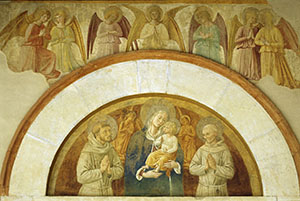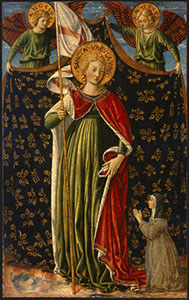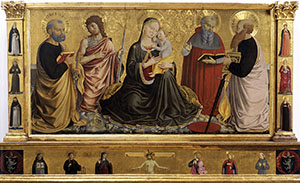
Virgin and Child with Saints Francis and Bernard and Saint Fortunatus Enthroned Surrounded by Angels, Church of St. Fortunatus, Montefalco.

Saint Ursula, Two Curtain-bearing Angels and the Donor, National Gallery of Art, Washington.

Sapienza Nuova altarpiece, Umbria National Gallery, Perugia.
By the mid fifteenth century, Benozzo had earned the confidence and admiration of Pope Nicholas V, protector of the Reformed Franciscans of St. Fortunatus in Montefalco in the Umbria region, and it was probably through intercession by the Pope that he received an important new commission to fresco the renovated Franciscan convent of St. Fortunatus. There, in 1450, Benozzo painted the fresco of the Madonna and Child enthroned with angel musicians (now in a fragmentary state) and, in that same church, a Saint Fortunatus enthroned surrounded by angels (also now in a poor state of repair). He also painted the Madonna of the Girdle on the beautiful altarpiece, now housed in the Vatican Picture Gallery, which decorated the main altar as well as the Virgin and Chil d with Saint Francis and Saint Bernard on the lunette over the entrance door of the church.
The works for the Convent of St. Fortunatus were followed by those for the greater chapel of the church dedicated to St Francis, which the conventual monks had built within the town of Montefalco. This prestigious engagement allowed Benozzo to demonstrate his talent as a painter in his own right, with a significant commission. The frescoes depicting the Stories of the Saint were probably painted in a very short space of time. An inscription in ancient-style characters identifies Benozzo as the painter and 1452 as the year of production. In order to paint this work and the many others he produced in Montefalco during the three years he spent there, Benozzo enlisted the help of co-workers, as was customary in fifteenth-century artists’ studios.
In the same church, he frescoed the chapel dedicated to Saint Jerome, in which the scenes illustrating episodes from the life of the Saint are accompanied by a trompe l’oeil Gothic polyptych. Indeed, Benozzo used illusionistic fresco techniques to paint a panel featuring an illustrated altar-step, framed by carved wooden and gilded carpentry. This technical device reappears frequently in the artist’s work, creating sophisticated trompe l’oeil effects in which he uses fresco work to imitate panel painting. He used actual panel painting, on the other hand, for the Virgin and Child with Saints Francis and Bernard and the Commissioner, Fra Iacopo and the beautiful panel (now in the National Gallery in Washington) depicting Saint Ursula with two curtain-bearing angels and the donor. During his three years in Montefalco, Benozzo undoubtedly made a name for himself among the local painters and clients. Indeed, he earned such prestige among clients that he was engaged to "restore" an ancient image of Saint Claire of Montefalco which had been frescoed in the Augustinian convent dedicated to her.
In 1453, thanks once again to the favour of Pope Nicholas V, he was called to Viterbo to paint a cycle of frescoes in the Clarisse Monastery in Santa Rosa. These are now lost, but some frescoes attributed to Gozzoli’s school still survive in the oratory at the Convent of the Minori Osservanti on Mount Calvario on Bisentina Island, Lake Bolsena. On completion of these works, Benozzo returned to Rome where, in the meantime, "il Beato Angelico" (the Blessed Angelic One) vhad returned to work on his final pieces. Angelico died on 18th February 1455 and was buried at the Dominican Church of Santa Maria Sopra Minerva.
In Rome, Benozzo was now enjoying the esteem and protection of the Pope, receiving new commissions including the decoration of the most important noble family chapel in the Basilica of St. Mary of the Altar of Heaven. Having established himself among his clients as Angelico’s "heir", he was engaged to paint the altarpiece of the oratory of the Church of San Girolamo in the city of Perugia, where foreign students attending the University of Perugia, founded by Bishop Guidalotti in 1427, were accommodated. This altarpiece, known as the "Sapienza nuova" after the university it was created for, is now housed in the National Gallery in Umbria together with the other one previously painted by Fra Angelico (Angelic Friar) for the same client.
Another work attributable to this period is the fine panel painting from the Collegiate Church in Sermoneta depicting the Madonna and the angels.
Soon, however, the artist saw the need to return to Florence, his city of birth, where he could assert himself as the heir and successor of his master, "il Beato Angelico" (the Blessed Angelic One).
Serena Nocentini